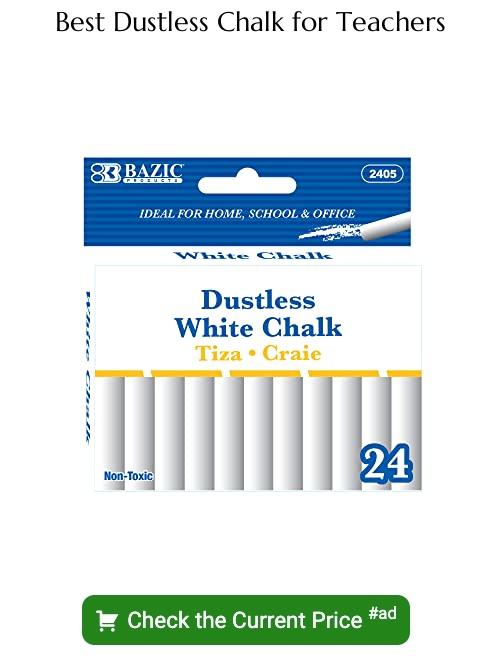Last updated on
Discover the benefits and composition of dustless chalk, a classroom staple designed for a cleaner and more allergen-free environment.
Key takeaways:
- Dustless chalk minimizes dust for cleaner surfaces.
- Environmentally friendly with reduced carbon dioxide emissions.
- More durable, extends chalkboard and chalk lifespan.
- Heavier materials and binding agents prevent airborne dust.
- Health benefits include reduced respiratory issues and skin irritation.
Composition and Benefits of Dustless Chalk
Crafted from calcium sulfate or calcium carbonate, dustless chalk is designed for minimal residue, making it an ideal choice for cleaner, less dusty surfaces. The transformative edge lies in the addition of a moisture content which allows particles to cling together instead of dispersing into the air.
Alongside tidier blackboards, reduced airborne particles benefit those with dust sensitivities and allergies, ensuring a more inclusive environment for all participants. Moreover, its smoother texture glides effortlessly across surfaces, creating uninterrupted lines for clarity in presentation, enhancing both teaching and creative endeavors.
Environmental Impact of Dustless Chalk
While traditional chalk may contribute to dust accumulation and potential respiratory concerns, dustless chalk offers an environmentally friendly advantage. Composed primarily of calcium sulfate rather than calcium carbonate, the manufacturing process of dustless chalk reduces the release of carbon dioxide, a greenhouse gas linked to climate change.
In classrooms and other settings, the minimal dust emitted from this chalk variety curtails the settling of particulates on surfaces, lessening the need for frequent cleaning with chemical agents that could harm the environment. Furthermore, by mitigating airborne dust, the use of dustless chalk contributes to maintaining better indoor air quality.
It is also worth noting that dustless chalk can be less abrasive to chalkboards, extending the life of both the writing surface and the chalk itself. This durability aids in reducing waste, as users may not need to discard stubs as frequently as with traditional chalk.
Last but not least, packaging for dustless chalk tends to prioritize environmental considerations, often using recyclable materials that lessen the ecological footprint. This mindfulness in packaging complements the sustainable nature of the chalk, reinforcing its eco-friendly profile.
How Dustless Chalk Works
Traditional chalk releases particles into the air upon contact with a blackboard because it is made from gypsum, calcium sulfate dihydrate, which produces dust. Dustless chalk, however, incorporates materials like calcium carbonate, which have a heavier base weight, minimizing the lift-off of dust particles when the chalk is used.
A binding agent is also added to dustless chalk to ensure that the particulate matter adheres more effectively to the chalk itself instead of becoming airborne. This binding agent maintains the structural integrity of the chalk, reducing breakage and further decreasing the amount of dust produced during use.
Laboratory tests often evaluate the amount of airborne dust generated by chalk products to classify them as dustless. Chalk that produces a negligible amount of airborne dust under these conditions is then marketed as dustless—a designation important for settings such as classrooms, art studios, and any indoor areas where air quality is a concern.
Anti-dust technology in chalk manufacturing has evolved to enhance chalk’s usability while preventing the chalk dust from becoming a nuisance or a health hazard. Through a combination of heavier materials and binding agents, dustless chalk provides a cleaner and more pleasant user experience.
Health Considerations for Users of Dustless Chalk
Dust particles from traditional chalk can trigger respiratory issues such as asthma and allergies. Dustless chalk minimizes this problem as it generates significantly less dust upon use. Its smoother composition produces fewer particulates that can be inhaled, which is particularly beneficial in classrooms where the air quality must be safe for young students.
Manufacturers often use materials like calcium carbonate in dustless chalk, which reduces airborne particles.
Individuals with skin sensitivities also find dustless chalk gentler on their hands. The absence of the cloud of chalk dust not only improves the air quality but also reduces the chances of developing dryness or irritation from excessive contact with chalk particles. Additionally, dustless chalk has a composition that is less abrasive on surfaces, which can reduce skin wear over time for frequent users.
For teachers and students who use chalkboards throughout the day, the health benefits of reduced dust exposure add up. It ensures a cleaner breathing environment and less irritation, contributing to a more comfortable and health-conscious learning or teaching experience.
Cost Analysis of Dustless Chalk Vs Traditional Chalk
When evaluating the cost of dustless versus traditional chalk, there are several factors to consider:
- Initial Price: Dustless chalk tends to have a higher upfront cost than traditional chalk due to the manufacturing process and materials used to reduce dust.
- Quantity and Usage: Dustless chalk generally lasts longer as it wears down more slowly, which means you may purchase it less frequently.
- Health Costs: Reduced dust may mean fewer respiratory issues for users, potentially decreasing health-related expenses over time.
- Cleaning and Maintenance: With less dust, the need for regular cleaning of surfaces and surroundings lessens, saving on cleaning supplies and labor.
- Equipment Longevity: Dustless chalk may extend the life of chalkboards and related equipment as there is less abrasive dust to cause wear.
- Environmental Considerations: While harder to quantify, using dustless chalk could potentially reduce environmental cleaning and health costs long-term.
Consumers should weigh these variables against their specific needs and budget to decide on the most cost-effective option.
Recap:





